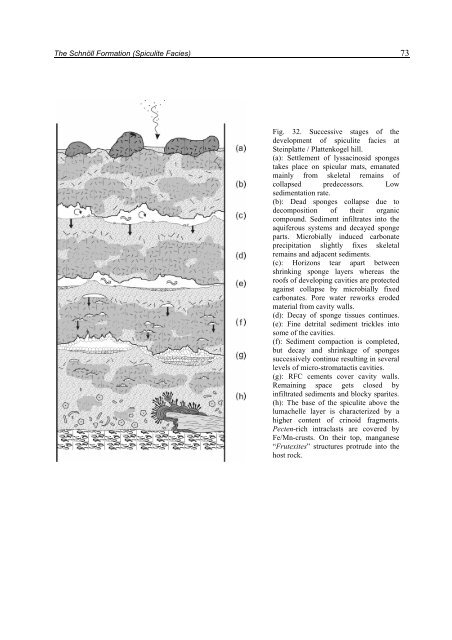Porifera-microbialites of the Lower Liassic (Northern Calcareous ...
Porifera-microbialites of the Lower Liassic (Northern Calcareous ...
Porifera-microbialites of the Lower Liassic (Northern Calcareous ...
Create successful ePaper yourself
Turn your PDF publications into a flip-book with our unique Google optimized e-Paper software.
The Schnöll Formation (Spiculite Facies) 73<br />
Fig. 32. Successive stages <strong>of</strong> <strong>the</strong><br />
development <strong>of</strong> spiculite facies at<br />
Steinplatte / Plattenkogel hill.<br />
(a): Settlement <strong>of</strong> lyssacinosid sponges<br />
takes place on spicular mats, emanated<br />
mainly from skeletal remains <strong>of</strong><br />
collapsed predecessors. Low<br />
sedimentation rate.<br />
(b): Dead sponges collapse due to<br />
decomposition <strong>of</strong> <strong>the</strong>ir organic<br />
compound. Sediment infiltrates into <strong>the</strong><br />
aquiferous systems and decayed sponge<br />
parts. Microbially induced carbonate<br />
precipitation slightly fixes skeletal<br />
remains and adjacent sediments.<br />
(c): Horizons tear apart between<br />
shrinking sponge layers whereas <strong>the</strong><br />
ro<strong>of</strong>s <strong>of</strong> developing cavities are protected<br />
against collapse by microbially fixed<br />
carbonates. Pore water reworks eroded<br />
material from cavity walls.<br />
(d): Decay <strong>of</strong> sponge tissues continues.<br />
(e): Fine detrital sediment trickles into<br />
some <strong>of</strong> <strong>the</strong> cavities.<br />
(f): Sediment compaction is completed,<br />
but decay and shrinkage <strong>of</strong> sponges<br />
successively continue resulting in several<br />
levels <strong>of</strong> micro-stromatactis cavities.<br />
(g): RFC cements cover cavity walls.<br />
Remaining space gets closed by<br />
infiltrated sediments and blocky sparites.<br />
(h): The base <strong>of</strong> <strong>the</strong> spiculite above <strong>the</strong><br />
lumachelle layer is characterized by a<br />
higher content <strong>of</strong> crinoid fragments.<br />
Pecten-rich intraclasts are covered by<br />
Fe/Mn-crusts. On <strong>the</strong>ir top, manganese<br />
“Frutexites” structures protrude into <strong>the</strong><br />
host rock.

















